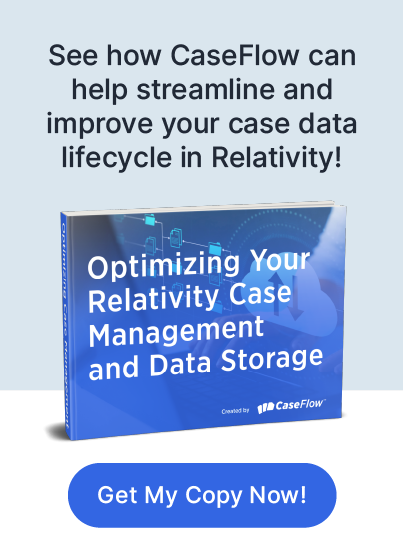Archiving Relativity Workspaces: Addressing the Complexities With Ease

Ask any litigation support team what's taking up the most digital space, and they'll probably point you to their Relativity environment. Over time, workspaces pile up: Cases open, close, stall, and then resume. With each stage, new data enters the system, while old data quietly lingers.
That wouldn't be a problem if data were free, but it's not.
Storage in Relativity—especially in RelativityOne—isn't just about space; it's about money, performance, and risk. As legal datasets grow, firms are under increasing pressure to manage what stays live and what can be safely moved off production. Simply "closing" a Matter doesn't remove it from the environment. If a workspace remains in production, it continues to take up space, and worse, it may still be accessible to unauthorized individuals or workflows.
This guide is about getting ahead of that. You’ll learn what it actually means to archive Relativity workspaces, why so many firms struggle with it, and how to do it right—without making a mess of future audits, compliance obligations, or restores.
What Does It Really Mean to Archive a Relativity Workspace?
The word "archive" gets thrown around frequently, but it tends to be misunderstood. Archiving a Relativity workspace doesn't mean deleting it; it means removing that workspace from your production environment while retaining the ability to restore it later if necessary.
There are several ways that this can happen:
- Manual exports of load files and native documents (often used for bare-bones backups)
- SQL backups for on-prem environments, as these require IT involvement and don't capture everything necessary for a smooth restore
- Repository workspaces, which enable you to reduce review costs but don't fully offload the workspace
The most robust option, especially in RelativityOne, is using Relativity ARM—or Archive, Restore, Move—to fully capture and package all data, coding decisions, saved searches, and settings for archiving.
On RelativityOne, ARM integrates directly with the cloud environment, giving you more control over where archived workspaces go (e.g., nearline or cold storage), how long they're retained, and how easily they can be restored. On-prem users don't have these built-in tools, so they rely more heavily on internal workflows or third-party automation like CaseFlow, which is designed to support complete lifecycle management of Relativity data.
The key takeaway is that archiving is not just about pulling the plug; it's also a structured process that should preserve access, reduce cost, and prevent operational disruption.
Why Archiving Isn't as Simple as It Sounds
If archiving were just a matter of hitting an "off" button, everyone would already be doing it. The truth is that a few critical factors make it more complex.
- Metadata Retention: Not all metadata should be wiped, as some of it may be needed for compliance checks, case reactivation, or internal audits. But keeping too much can inflate storage costs unnecessarily.
- Security: Just because a workspace is archived doesn't mean it's off-limits. Access permissions, user activity logs, and data encryption should still be in place. Cold data doesn't mean exposed data.
- Overlooked Dependencies: Some firms archive workspaces that are still feeding saved searches, dashboards, or templates used in other cases. That breaks things, creates confusion, and wastes time.
- Policy Gaps: Many firms simply don't have a formal data lifecycle policy in place. So, archiving becomes a quarterly panic, not a routine workflow. Without automation or clear rules, people hesitate to make decisions, and the data piles up.
Let's take a real-world example, courtesy of CaseFlow: A mid-sized firm had over fifty closed cases, each with 10 to 30 GB of data, still stored in Relativity production. There was no defined point at which the workspaces should be archived, so no one was sure if the attorneys still needed them. Meanwhile, the firm was paying for 1.5 TB of unnecessary storage.
When Should You Archive a Relativity Workspace?
There's no one-size-fits-all answer here. But there are a few clear signs.
If a matter is fully resolved, with no active appeal or compliance hold, and hasn't been touched in six months, archive it. If the client has signed off, the workspace has no active review batches, and the data has already been produced, archive it. If your firm has already transitioned that case's materials into an offline records system or external archive, ask: Why is it still live?
You don't need a stopwatch; you need criteria. Here's a rough framework to guide decision-making:
- Closed: The legal matter is closed, with no appeals or holds.
- Idle: No one has accessed the workspace in months.
- Reviewed: All coding, productions, and exports are done.
- Transferred: Any long-term records retention has been logged elsewhere.
If you check all four boxes, you're ready. If not, you're probably still in the gray zone, so don't rush, but do start preparing.
Archiving Without Breaking Everything: A Real Workflow
Here's what a practical, no-drama archive process might look like:
- Check Workspace Activity. Look at audit logs, user activity, and any queued review batches. Confirm that it's truly idle.
- Tag It. Internally label it as "To Archive" or assign it to a quarterly archive cycle. That makes it easier to track.
- Alert Stakeholders. Notify the attorney team, especially lead counsel and the client contact. Give them a short window to flag concerns.
- Back Up Data (If Needed). Depending on firm policy, you may want to export select documents or logs to an external storage location before archiving.
- Run the Archive Job. In RelativityOne, use ARM. In on-prem, follow your firm's structured export/archive SOP.
- Document the Process. Capture what was archived, when, and why. Store that note where your audit or compliance team can find it later.
Don't just hit delete. Deleting a workspace is final; it means no recovery. Unless you're under a strict data destruction mandate, stick with archival.
Why Manual Archiving Breaks Down (and How Automation Fixes It)
Let's be honest: Manual archiving works, but only until it doesn't. You can't rely on someone remembering to clean up workspaces every quarter. You need a system.
An automated solution like CaseFlow handles the hard parts:
- It tracks workspace age and alerts you when something goes stale.
- It flags storage thresholds so you can act before costs spike.
- It uses approval workflows, enabling stakeholders to sign off quickly.
- It supports tiered storage, moving older data to cheaper infrastructure without disrupting performance.
In a firm with over twenty active cases and dozens of closed matters, that kind of automation is the difference between proactive management and a costly backlog.
This isn't unique to Relativity, of course. Tools like Microsoft Purview and Google Vault treat archiving as part of lifecycle governance. Legal teams should expect the same control and auditability from their e-discovery stack.
Common Mistakes (and How to Avoid Them)
Mistakes aren't merely common; they're predictable. Here are four that come up often:
- Archiving without a formal policy
- Fix: Draft a workflow that includes retention, storage location, and reactivation rules.
- Archiving before a final review is done
- Fix: Build in automated checks for open batches or unresolved tags.
- Not monitoring archived data
- Fix: Set review reminders for long-term archived workspaces.
- Thinking that archiving is a one-time project
- Fix: Make it a routine process—monthly or quarterly—and assign ownership.
Archiving Is Just One Piece of the Lifecycle
Smart firms don't treat archiving as the end; they treat it as a checkpoint in a larger strategy.
Good lifecycle policies cover:
- Workspace Age Limits: Determine how long a case can stay live.
- Regular Audits: Find out who’s checking for dormant data.
- Standard Tags: Use labels like "Inactive" or "Ready for Archive" to guide workflows.
- Cross-Team Responsibility: Know that IT, legal ops, and practice teams all need to be aligned.
If it's everyone's job, it ends up being no one's job. Assign ownership, and make it part of your firm's operational rhythm.
Final Note: Archiving Is Legal Hygiene
Cleaning up your Relativity workspaces isn't just about saving money; it's also about running a cleaner, smarter, and more secure operation. It protects your firm, your clients, and your peace of mind.
If you're tired of chasing storage bills and guessing which matters are still "live," start with this: Put a system in place. Whether that's a manual checklist or an automated workflow through CaseFlow, it's one less thing to worry about in the long run.
Honestly, that's the kind of cleanup worth doing.
Ready to take control of your Relativity data lifecycle and eliminate unnecessary costs and wasted time? CaseFlow provides the automation that you need to proactively manage your Relativity storage, seamlessly transitioning cases through Repository, Cold Storage, and Archive based on your specific requirements. Don't let manual processes bog you down; see how CaseFlow can save your law firm time and money. Contact us today, and discover the power of automated Relativity data lifecycle management.



